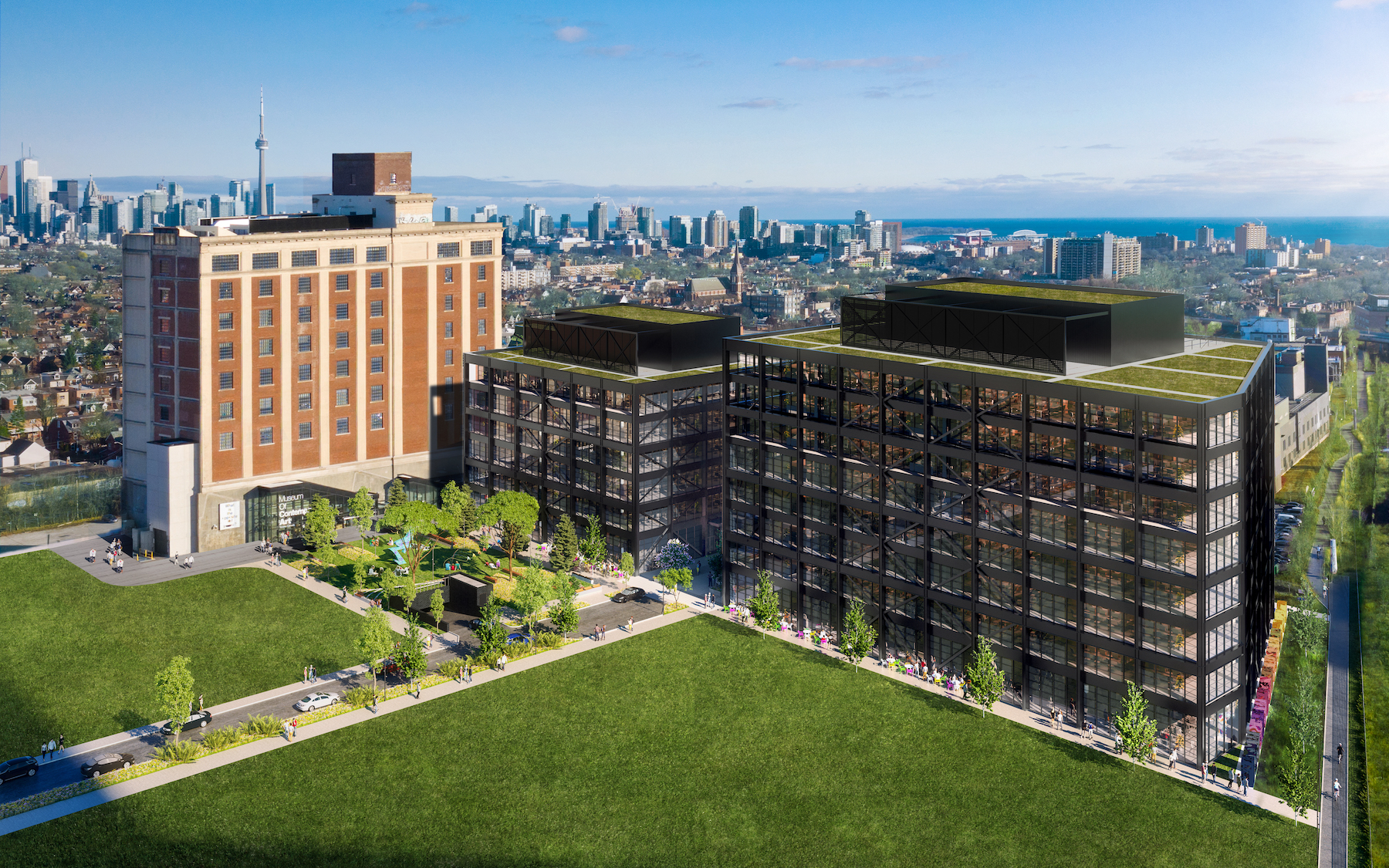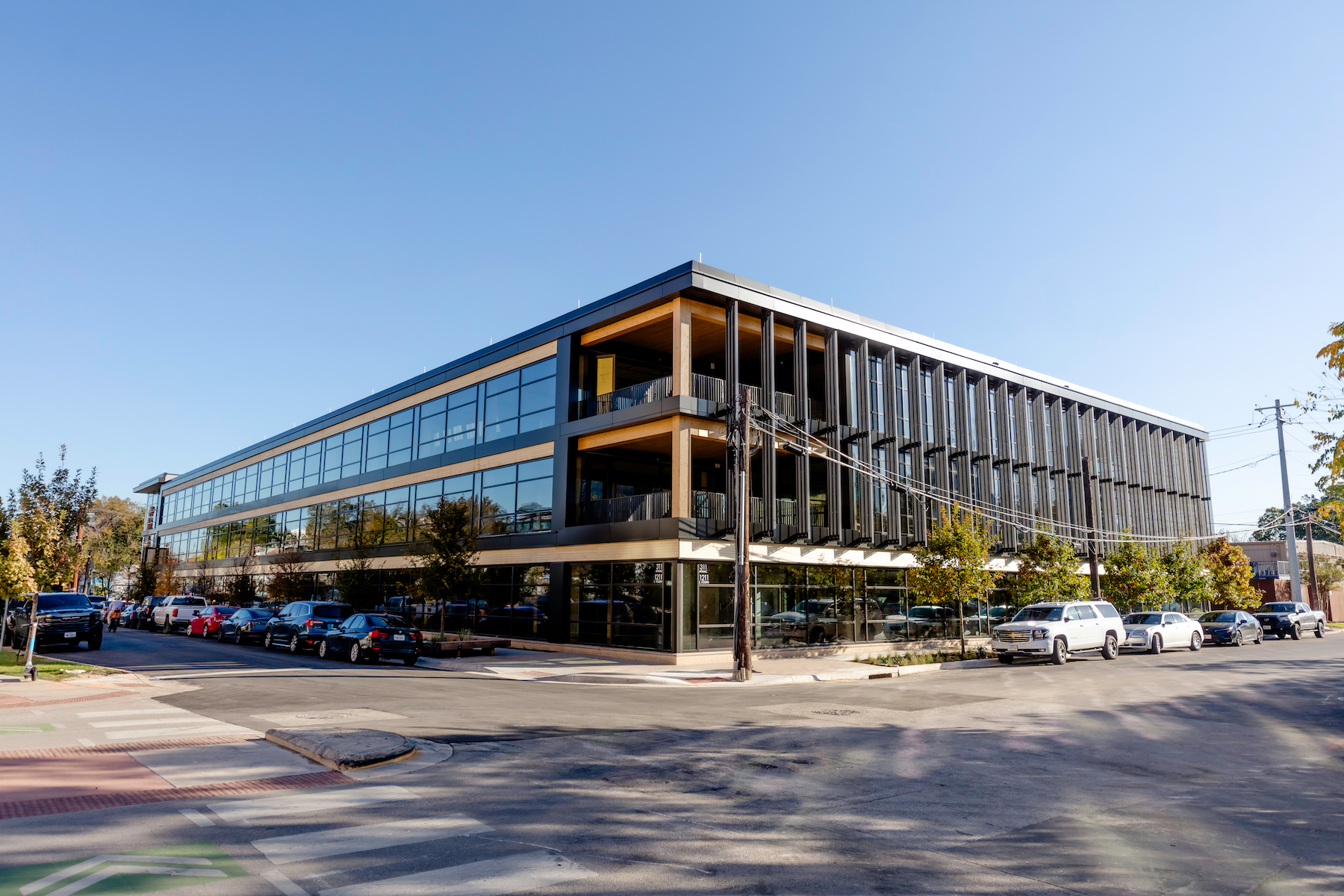On January 29, the owner/developer Hines stated that it had completed construction on a three-story, 92,000-sf office and residential building in East Austin, Texas. The building, known as T3 ATX Eastside, features mass timber as its primary construction material. It is one of 26 buildings in various stages of design, construction, or completion that subscribe to Hines’ T3 (shorthand for Timber, Transit, and Technology) concept, which the developer introduced in 2016 with the completion of a 221,552-sf, seven story office building in the North Loop neighborhood of downtown Minneapolis.
Hines currently has other T3s completed, or nearly so, in Atlanta, Nashville, Denver, and two buildings in Toronto. The East Austin building, with 15 corporate residential suites, is the first T3 to include housing. Mike Horvath, Vice President of Conceptual Construction in Hines’ Houston office, explains that the decision to include residential in future T3s will boil down to whether the building can absorb the cost premium associated with using mass timber via its rents.
Hines’ embrace of mass timber, though, is an exception. Mass timber projects might get lots of press, but they represent a sliver of total construction activity. As of December 2023, there was a total of 2,035 mass timber projects (multifamily, commercial, and institutional) in progress or built in the U.S., according to Woodworks|The Wood Building Council’s latest estimates. Last year’s bankruptcy filing by Structurlam, a leading mass timber manufacturer, after Walmart canceled a lucrative supply contract for its 350-acre Home Office campus in Arkansas, accentuated how volatile this niche can be. (Structurlam was subsequently sold to Mercer Mass Timber, North America’s largest mass timber manufacturer, for just over $8 million. According to its parent company Mercer International, Mercer Mass Timber entered 2024 with a nearly $100 million order book.)
On a positive note, building codes are becoming more receptive to using mass timber for taller buildings: the 2021 International Building Code allows mass timber to be used for Type IV-A buildings with residential and business occupancies up to 18 stories. Taller mass timber buildings in Milwaukee, Wis., and in Sweden have achieved three-hour fire ratings, and the proposed 2024 IBC includes language that removes encapsulation requirements for Type IV-B buildings up to 12 stories, an important change for a material whose purpose is as much aesthetic as structural.
Will a building’s rent offset mass timber’s premium?
“We’re bullish about mass timber, and can’t see the market moving in the opposite direction,” says Steve Cavanaugh, AIA, LEED AP, Principal and Design Lead for DLR Group in Chicago, which has been the Architect of Record on all of Hines’ T3 projects.

Cavanaugh says his firm now includes mass timber in conversations about every one of its projects. Whether DLR Group favors mass timber, he elaborates, depends on several considerations that include the scale and use of the building, code viability, and zoning. Cost is also a factor. “We spend a lot of time optimizing the structure and its financial viability and value,” says Cavanaugh.
Horvath says that while virtually all of Hines’ project teams want to use mass timber, it sometimes doesn’t pencil out cost-wise. He notes, too, that some metros, like Houston, are still building under older IBC codes that restrict the use of mass timber. (When BD+C brought up the resilient fire rating achieved by Ascent, the 25-story mass timber high rise in Milwaukee, Horvath lamented that most municipalities “aren’t reading the papers about that.”)
He adds, parenthetically, that the insurance industry hasn’t bought in completely on mass timber, either, especially in Europe.
Mass timber construction conveys a building’s authenticity
Perhaps the biggest hurdle for broader use of mass timber, says Horvath, is “knowledge and understanding. I don’t think most users have a true appreciation for the material.” That could be changing, however, as codes become more lenient, and mass timber projects attract more developers and AEC firms. Horvath points specifically to two projects—the 251,000-sf T3 Bayside in Toronto, designed by the Danish firm 3XN Architects; and the 235,000-sf, six-story T3 RiNo in Denver, designed by Pickard Chilton Architects—as being noteworthy examples of the form’s aesthetic potential.

Cavanaugh also touts mass timber’s “authenticity,” conveyed through its exposed framing and sustainable attributes.
He and Horvath believe that mass timber will gain market share as a building material, especially now that codes are catching up to market demand. And Cavanaugh thinks that over the next few years developers will arrive at mass timber’s “sweet spot” in terms of building height.
Horvath anticipates more “hybrid” buildings with combinations of mass timber, steel, and concrete. He also expects mass timber to be more prevalent in multifamily projects and in industrial construction for building types like data centers.
Related Stories
MFPRO+ Special Reports | May 6, 2024
Top 10 trends in affordable housing
Among affordable housing developers today, there’s one commonality tying projects together: uncertainty. AEC firms share their latest insights and philosophies on the future of affordable housing in BD+C's 2023 Multifamily Annual Report.
Codes and Standards | May 3, 2024
New York City considering bill to prevent building collapses
The New York City Council is considering a proposed law with the goal of preventing building collapses. The Billingsley Structural Integrity Act is a response to the collapse of 1915 Billingsley Terrace in the Bronx last December.
Mass Timber | Apr 22, 2024
British Columbia changing building code to allow mass timber structures of up to 18 stories
The Canadian Province of British Columbia is updating its building code to expand the use of mass timber in building construction. The code will allow for encapsulated mass-timber construction (EMTC) buildings as tall as 18 stories for residential and office buildings, an increase from the previous 12-story limit.
Codes and Standards | Apr 12, 2024
ICC eliminates building electrification provisions from 2024 update
The International Code Council stripped out provisions from the 2024 update to the International Energy Conservation Code (IECC) that would have included beefed up circuitry for hooking up electric appliances and car chargers.
Codes and Standards | Mar 15, 2024
Technical brief addresses the impact of construction-generated moisture on commercial roofing systems
A new technical brief from SPRI, the trade association representing the manufacturers of single-ply roofing systems and related component materials, addresses construction-generated moisture and its impact on commercial roofing systems.
Sustainability | Mar 13, 2024
Trends to watch shaping the future of ESG
Gensler’s Climate Action & Sustainability Services Leaders Anthony Brower, Juliette Morgan, and Kirsten Ritchie discuss trends shaping the future of environmental, social, and governance (ESG).
Green | Mar 5, 2024
New York City’s Green Economy Action Plan aims for building decarbonization
New York City’s recently revealed Green Economy Action Plan includes the goals of the decarbonization of buildings and developing a renewable energy system. The ambitious plan includes enabling low-carbon alternatives in the transportation sector and boosting green industries, aiming to create more than 12,000 green economy apprenticeships by 2040.
Codes | Feb 9, 2024
Illinois releases stretch energy code for building construction
Illinois is the latest jurisdiction to release a stretch energy code that provides standards for communities to mandate more efficient building construction. St. Louis, Mo., and a few states, including California, Colorado, and Massachusetts, currently have stretch codes in place.
Modular Building | Jan 19, 2024
Virginia is first state to adopt ICC/MBI offsite construction standards
Virginia recently became the first state to adopt International Code Council/Modular Building Institute off-site construction standards.
Modular Building | Jan 19, 2024
Building with shipping containers not as eco-friendly as it seems
With millions of shipping containers lying empty at ports around the world, it may seem like repurposing them to construct buildings would be a clear environmental winner. The reality of building with shipping containers is complicated, though, and in many cases isn’t a net-positive for the environment, critics charge, according to a report by NPR's Chloe Veltman.

















